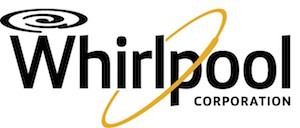 The Whirlpool Corporation (NYSE: WHR) of Benton Charter Township, MI, is an industry leader in the manufacture and sale of home appliances for a variety of brands, including Amana, Maytag and KitchenAid. This corporation is focused on developing innovations that go beyond high energy efficiency appliances, such as its HybridCare Heat Pump dryer that recycles hot, humid air so that a vent isn’t required, making it a good option for urban apartments. Near the end of December, Whirlpool’s stock hit a 52-week high of $194.99 per share. Even with this pricey per share cost, many investment pundits are considering the company a buy, especially as the company has been beating some of its earning expectations on the way towards 2018 earnings targets.
The Whirlpool Corporation (NYSE: WHR) of Benton Charter Township, MI, is an industry leader in the manufacture and sale of home appliances for a variety of brands, including Amana, Maytag and KitchenAid. This corporation is focused on developing innovations that go beyond high energy efficiency appliances, such as its HybridCare Heat Pump dryer that recycles hot, humid air so that a vent isn’t required, making it a good option for urban apartments. Near the end of December, Whirlpool’s stock hit a 52-week high of $194.99 per share. Even with this pricey per share cost, many investment pundits are considering the company a buy, especially as the company has been beating some of its earning expectations on the way towards 2018 earnings targets.
Whirlpool patent applications recently published by the U.S. Patent and Trademark Office continue to showcase a great deal of research and development focused on home appliances. We noticed a couple of inventions related to dishwashers, including one dishwasher with a lighting array designed to help a user better see the dishes carried by a rack. Cooking ranges were another area of R&D focus and we discuss one patent application that claims a suspended cooktop above an oven that may be raised or lowered. We also discuss a patent application discussing home networks to which appliances may be connected.
Patents issued to Whirlpool in recent weeks also focus on home appliances and we noticed another couple of technologies for cooking appliances. One such patent we noticed protects a device which can provide a temperature reading of food within an oven to a user interface outside of the oven. We share another patent related to a clothes dryer utilizing a system of determining a laundry load size to determine an amount of treatment solution to add to the load. We also discuss an interesting system that enables sales vendors to perform better demonstrations on appliance products to encourage consumer purchases of appliances.
[Companies-1]
Whirlpool’s Patent Applications: Home Appliances Galore, from Energy Efficient Laundry Machines to Adjustable Dishwashers and Cooktops
The history of Whirlpool includes the development of some landmark consumer appliances; the company claims the world’s first electric wringer clothes washer and the first domestic microwave appliance in its corporate history. The 2015 Consumer Electronics Show is set to feature a wide array of the latest innovations developed by this company, which include a variety of kitchen and laundry care technologies for use in home environments. One of Whirlpool’s latest laundry care innovations, the SWASH system which provides dry cleaning and wrinkle removal services in a home closet or other small enclosed space, was actually developed in partnership with Procter & Gamble, showcasing the company’s ability to work jointly with other corporations developing home and personal care technologies for the creation of new and useful home appliances.
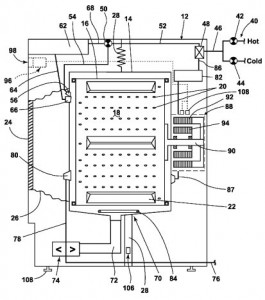 Energy efficiency upgrades to conventional laundry treating apparatuses are being sought by Whirlpool. The company recently tried to improve its intellectual property strength in this sector through the filing of U.S. Patent Application No. 20140366586, which is titled Efficient Energy Usage for a Laundry Appliance (shown right). The patent application claims a laundry treating appliance which includes a rotatable drum for receiving a laundry load and is driven by a motor, a moisture sensor which determines the amount of moisture remaining in a laundry load as well as a controller that receives a moisture signal and operates a motor to apply a centrifugal force to the laundry load until the energy needed to extract moisture reaches a certain threshold. This system is meant to establish an optimal efficiency for washer and dryer units as a pair, which can be difficult as most washers utilize electricity while many dryers utilize gas for heating.
Energy efficiency upgrades to conventional laundry treating apparatuses are being sought by Whirlpool. The company recently tried to improve its intellectual property strength in this sector through the filing of U.S. Patent Application No. 20140366586, which is titled Efficient Energy Usage for a Laundry Appliance (shown right). The patent application claims a laundry treating appliance which includes a rotatable drum for receiving a laundry load and is driven by a motor, a moisture sensor which determines the amount of moisture remaining in a laundry load as well as a controller that receives a moisture signal and operates a motor to apply a centrifugal force to the laundry load until the energy needed to extract moisture reaches a certain threshold. This system is meant to establish an optimal efficiency for washer and dryer units as a pair, which can be difficult as most washers utilize electricity while many dryers utilize gas for heating.
Anytime we see mention of the Consumer Electronics Show, we’re reminded of our coverage of last year’s CES which introduced many people to the idea of the Internet of Things. We’ve seen a couple of Whirlpool technologies aimed at capitalizing on the growing IoT trend, including the innovation outlined in U.S. Patent Application No. 20140362991, which is titled Method of Connecting an Appliance to a WiFi Network. The patent application claims a method of provisioning an appliance to connect to a home WiFi network through secure communication with a wireless access point enabled by an encryption key contained within a mobile device. The appliance also contains a wireless communication device and a software protocol that operates the wireless communication device and the mobile device in an unsecured short range communication mode. This innovation enables wireless connectivity of appliances to a WiFi network when the wireless communication device included on an appliance when that wireless device doesn’t include an interface for accessing a service set identifier (SSID), required for wireless network connectivity.
Homeowners who are thinking about making some renovations may want to pay attention to some of the intriguing inventions developed by Whirlpool for kitchen appliances, especially dishwashers. Improved designs for dishwashers with adjustable racks that afford a user the ability to adjust the space available in the top rack are at the center of U.S. Patent Application No. 20140346937, entitled Height Adjuster Mechanism for a Dishwasher Dish Rack. The vertical height adjustment mechanism of this invention is both cost-effective to manufacture while being easier to operate than latching mechanisms used by prior art in the field. The dishwasher claimed by this patent application includes a dish rack supported by a member and an adjustment mechanism for shifting the dish rack between lowered and raised positions. The mechanism includes multiple base members and shiftable support bodies as well as a control arm with multiple lever members which are pivotably supported by the base members. This invention is designed to provide easier access to the raising and lowering controls without any restriction from the latching mechanism. A dishwasher with improved lighting characteristics that gives users a better look into the wash tub is the focus of U.S. Patent Application No. 20140338708, filed under the title Dishwasher With Integrated Lighting. The dishwasher discussed in this patent application has a light source provided on a dish holder for illuminating dishes contained in the dish holder and a power source coupled to the light source. The power source has an electrical conductor which is provided with slack that allows the dish holder to move outside of the treatment chamber.
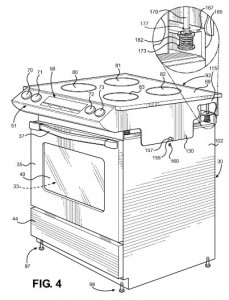 Cooking implements were another area of R&D focus for Whirlpool designers situated all over the world. Whirlpool S.A., a Brazilian subsidiary of the corporation, is responsible for the filing of U.S. Patent Application No. 20140345590, filed under the title Grid for Cooking Equipment. The invention is intended to improve thermal efficiency by reducing the wasteful consumption of fuel when trying to heat cooking utensils. The grid for cooking equipment claimed by Whirlpool is comprised by a crown formed by a plurality of fins. Flames pass through a plurality of holes formed on the crown when the burner is turned on. The fins of this invention are designed for the increased recovery of heat generated for heating cooking utensils, the recovered heat being used to preheat the air/fuel mixture, which achieves a more efficient combustion process. An adjustable cooktop which can withstand greater thermal and mechanical stresses is described within U.S. Patent Application No. 20140319122, which is titled Range with Suspended Cooktop (shown left). The cooking appliance claimed here includes a cabinet with an oven cavity, a cooktop positioned above the cavity and a mechanism interlocking the cooktop to the cavity in such a way that allows the cooktop to be vertically shifted. The mechanism allows for the shifting of the cooktop without additional stress created through changes to the mounting configuration of the cooktop over time, which can be especially damaging to glass cooktops.
Cooking implements were another area of R&D focus for Whirlpool designers situated all over the world. Whirlpool S.A., a Brazilian subsidiary of the corporation, is responsible for the filing of U.S. Patent Application No. 20140345590, filed under the title Grid for Cooking Equipment. The invention is intended to improve thermal efficiency by reducing the wasteful consumption of fuel when trying to heat cooking utensils. The grid for cooking equipment claimed by Whirlpool is comprised by a crown formed by a plurality of fins. Flames pass through a plurality of holes formed on the crown when the burner is turned on. The fins of this invention are designed for the increased recovery of heat generated for heating cooking utensils, the recovered heat being used to preheat the air/fuel mixture, which achieves a more efficient combustion process. An adjustable cooktop which can withstand greater thermal and mechanical stresses is described within U.S. Patent Application No. 20140319122, which is titled Range with Suspended Cooktop (shown left). The cooking appliance claimed here includes a cabinet with an oven cavity, a cooktop positioned above the cavity and a mechanism interlocking the cooktop to the cavity in such a way that allows the cooktop to be vertically shifted. The mechanism allows for the shifting of the cooktop without additional stress created through changes to the mounting configuration of the cooktop over time, which can be especially damaging to glass cooktops.
A lighting array for refrigerators that can help a user learn about additional features of which they may not be aware is the focus of U.S. Patent Application No. 20140268646, entitled Light Animation in an Appliance. The refrigerator of this invention includes a visual display situated at an interior compartment and a circuit operatively connected to a visual display which is configured to operate the display in a way that indicates an environmental system of the refrigerator. The visual display can provide a user with information on environmental controls for temperature and humidity as well as the condition of food items.
Issued Patents of Note: From Determining the Temperature of Food Inside an Oven to a Coffee Maker with Adjustable Serving Sizes
The number of patents issued to Whirlpool in recent years hasn’t been overwhelming, but we have profiled a number of intriguing innovations in home appliances and other technologies developed by the company in the past here on IPWatchdog. In 2013, Whirlpool was tied with a handful of companies at 156th overall in terms of U.S. patent grants earned that year, with a total of 189 U.S. patents issued to the company by the USPTO, an increase of 37 percent over 2012.
Cooking innovations abounded among the patents which we noticed during our latest survey of Whirlpool technologies. A system for gas ovens that includes programmable elements for controlling the output of gas burners is the subject of U.S. Patent No. 8882494, which is titled Smart Gas Burner System for Cooking Appliance. The cooking appliance claimed by the patent includes a gas control valve which contains a pressure sensor that measures a pressure of gas supplied to the burner from the gas control valve and outputs a signal indicative of the gas pressure to control the gas valve so that a user-defined quantity of heat is generated.
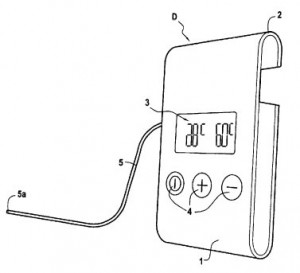 A technology that provides useful information on food as it is cooked within an oven is disclosed and protected by U.S. Patent No. 8920025, entitled Device for Registering the Temperature Inside a Foodstuff Placed in an Oven (shown right). The invention is designed to provide a low-cost electronic device that can be removably attached to an oven for the display of foodstuff temperatures on a user interface. The patent protects a portable electronic temperature registering device with a casing adapted to removably attach to an oven door and an electronic control unit electrically connected to a temperature probe inserted into a food product. The electrical connection supports a lower cost design that can be achieved by devices connecting wirelessly.
A technology that provides useful information on food as it is cooked within an oven is disclosed and protected by U.S. Patent No. 8920025, entitled Device for Registering the Temperature Inside a Foodstuff Placed in an Oven (shown right). The invention is designed to provide a low-cost electronic device that can be removably attached to an oven for the display of foodstuff temperatures on a user interface. The patent protects a portable electronic temperature registering device with a casing adapted to removably attach to an oven door and an electronic control unit electrically connected to a temperature probe inserted into a food product. The electrical connection supports a lower cost design that can be achieved by devices connecting wirelessly.
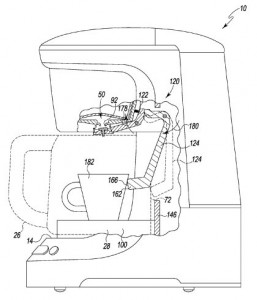 We were able to find a novel device for preparing just the right amount of coffee for a user, protected for Whirlpool by the issue of U.S. Patent No. 8904923, which is titled Coffee Maker Supporting Single Serving and Multiple Serving Operation (shown left). As the title suggests, the device is comprised of a coffee maker with multiple modes of operation for brewing multiple servings of coffee into a carafe or a single serving through the use of an adapter. The coffee maker claimed here has a drip stop assembly including a plug that can prevent fluid from advancing through an outlet of a filter basket while in a first position. In a second position, the plug allows the fluid to advance through the filter basket outlet while also preventing a carafe from being positioned upon the base.
We were able to find a novel device for preparing just the right amount of coffee for a user, protected for Whirlpool by the issue of U.S. Patent No. 8904923, which is titled Coffee Maker Supporting Single Serving and Multiple Serving Operation (shown left). As the title suggests, the device is comprised of a coffee maker with multiple modes of operation for brewing multiple servings of coffee into a carafe or a single serving through the use of an adapter. The coffee maker claimed here has a drip stop assembly including a plug that can prevent fluid from advancing through an outlet of a filter basket while in a first position. In a second position, the plug allows the fluid to advance through the filter basket outlet while also preventing a carafe from being positioned upon the base.
More innovations regarding appliances designed to treat soiled laundry are described within U.S. Patent No. 8914989, entitled Clothes Dryer and Method for Adjusting a Dilution of a Treating Solution Based on a Detected Clothes Load Size. The drying appliance which is disclosed here involves mechanisms for releasing a more exact amount of a clothes treating chemistry during dryer operation so as to reduce the risk that the treating solution will build up on the interior of the drying machine. The patent protects a method of operating a clothes dryer that involves automatically determining the size of a laundry load within a treating chamber and automatically determining the amount of a treating chemistry to be applied to the load based on its size. Enhancements to cleaning appliances, albeit those utilizing water, are also the focus of U.S. Patent No. 8919356, issued under the title Ozone Generation Module. The technology is intended to increase the use of ozonated water within a variety of appliances, including dishwashers and laundry washing machines, to clean and sanitize contact surfaces within the appliance while enhancing the fresh smell of the appliance, as well as the articles treated by those appliances. The patent claims an ozone supply module that has an electrical connection and a proton exchange membrane cell in contact with a water conveying system. The proton exchange membrane cell becomes energized through the use of the electrical connection and produces ozonated water from the water introduced by the water conveying system.
Finally, we were also intrigued by a patent issued to Whirlpool which protects techniques for providing product demonstrations of appliances to consumers that overcome issues associated with prior forms of using demo appliances to encourage consumer purchases. U.S. Patent No. 8856036, issued under the title Method of Providing Product Demonstrations, claims a method of enabling adaptable demonstrations of appliances by distributing appliances to vendors in different markets, each appliance having an internal communications network, and a user interface capable of multimedia display connected to the internal communications network. The user interface can receive a user input and provide an output relevant to the operation of the appliance. Vendors are also able to incorporate demonstration software related to the appliance through a smart device connected to the appliance. The use of the smart device can benefit a sales vendor by giving him or her a tool for controlling the appliance during a product demonstration.

![[IPWatchdog Logo]](https://ipwatchdog.com/wp-content/themes/IPWatchdog%20-%202023/assets/images/temp/logo-small@2x.png)

![[Advertisement]](https://ipwatchdog.com/wp-content/uploads/2024/04/Patent-Litigation-Masters-2024-sidebar-early-bird-ends-Apr-21-last-chance-700x500-1.jpg)

![[Advertisement]](https://ipwatchdog.com/wp-content/uploads/2021/12/WEBINAR-336-x-280-px.png)
![[Advertisement]](https://ipwatchdog.com/wp-content/uploads/2021/12/2021-Patent-Practice-on-Demand-recorded-Feb-2021-336-x-280.jpg)
![[Advertisement]](https://ipwatchdog.com/wp-content/uploads/2021/12/Ad-4-The-Invent-Patent-System™.png)







Join the Discussion
One comment so far.
Benny
January 21, 2015 02:14 amI read the claims of the ‘708 application. I can understand a manufacturer attempting to obtain a monopoly on a feature of a consumer appliance, but to call this “innovation” is an insult to the engineering profession.